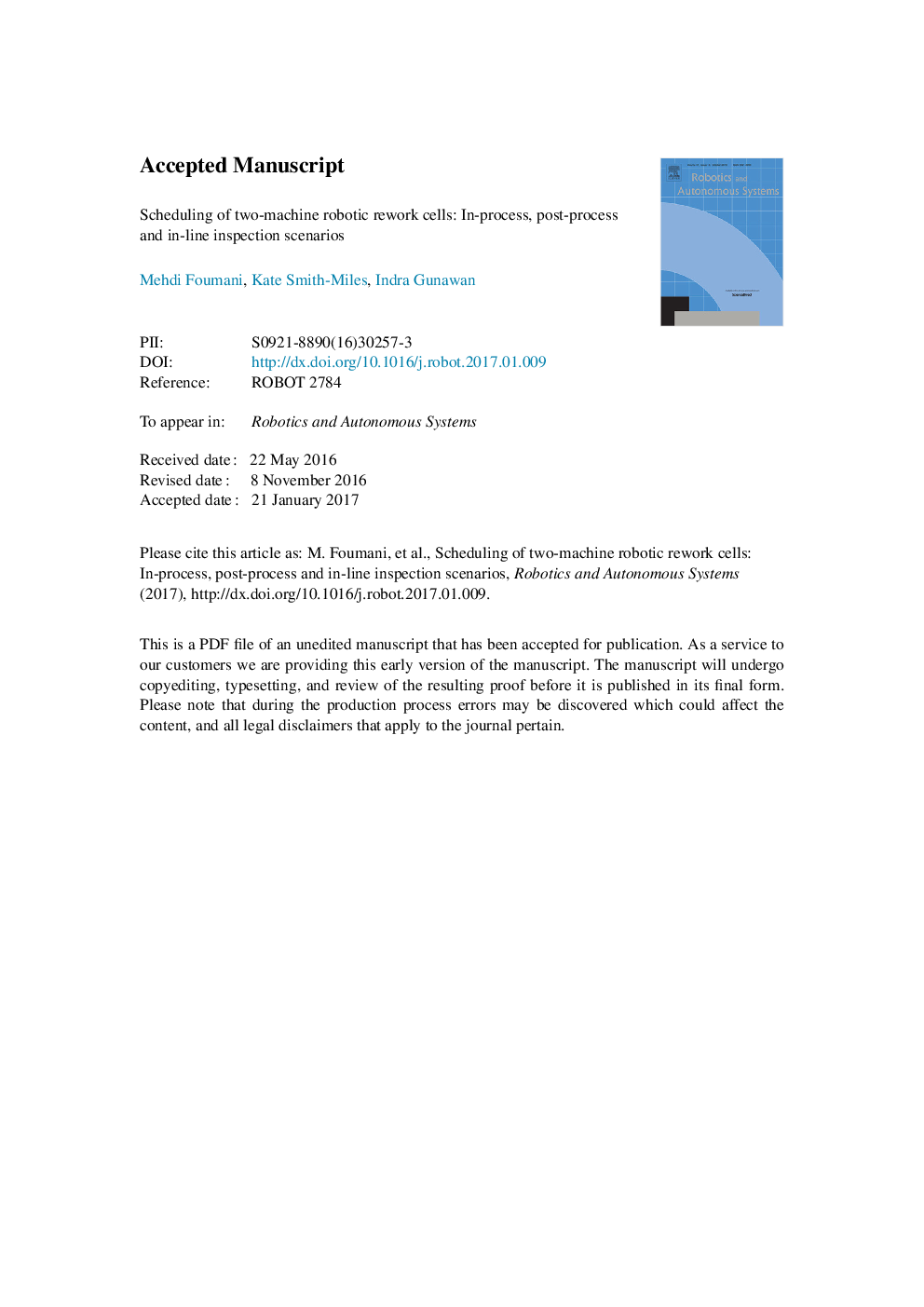| کد مقاله | کد نشریه | سال انتشار | مقاله انگلیسی | نسخه تمام متن |
|---|---|---|---|---|
| 4948794 | 1439851 | 2017 | 37 صفحه PDF | دانلود رایگان |
عنوان انگلیسی مقاله ISI
Scheduling of two-machine robotic rework cells: In-process, post-process and in-line inspection scenarios
ترجمه فارسی عنوان
برنامه ریزی سلول های بازسازی دو موتور رباتیک: سناریوهای بازرسی در فرآیند، پس از پردازش و در خط
دانلود مقاله + سفارش ترجمه
دانلود مقاله ISI انگلیسی
رایگان برای ایرانیان
کلمات کلیدی
برنامه ریزی، تولید چرخه، سلول روبوتیک، ساخت، بازرسی،
ترجمه چکیده
این مطالعه بر حسب یک مساله زمانبندی سلول دوبعدی روباتیک در سه مرحله بازبینی تمرکز دارد. ما اولین روش تحلیلی برای به حداقل رساندن زمان چرخه جزئی سلول ها با سناریوهای بازرسی در فرآیند و پس از پردازش را پیشنهاد می دهیم و سپس این سلول را به یک سلول روباتیک چند منظوره با سناریو بازرسی در خط تبدیل می کنیم. برای سناریو اول قطعات در یک دستگاه تولید با استفاده از سنسورهای چندگانه بررسی می شوند، در حالیکه روند بازرسی توسط ماشین بازرسی مستقل برای سناریوی دوم انجام می شود. متناوبا بازرسی می تواند توسط یک ربات چند کاره برای سناریوی سوم انجام شود. یکی از مشخصه های این ربات این است که می تواند بازرسی از بخش در حمل و نقل را انجام دهد. با این وجود، ربات قادر به تکمیل بخش انتقال نیست و آن را در دستگاه مقصد بعدی بارگذاری می کند، اگر یک خطا را در قسمت مشخص نماید. ماهیت تصادفی این فرآیند مانع از استفاده از روش های حل مسیر قطعی برای مسائل مربوط به زمانبندی می شود. در مرحله اول، ما یک روش اکتشافی را ارائه می دهیم که سیستم بازرسی چند سنسور را به سیستم بازرسی تک سنسور تبدیل می کند. زمان چرخه مورد انتظار دو سیکل متفاوت براساس توزیع هندسی مشتق می شود و سپس حداکثر بازده مورد انتظار برای سنسورهای بازرسی درون فرآیند و پس از پردازش دنبال می شود. در مرحله دوم، سیستم بازرسی را به یک سیستم بازرسی درون خطی با استفاده از یک ربات چند منظوره توسعه می دهیم. در نهایت، ما تعیین می کنیم که آیا از نظر فنی و قابل قبول جایگزین سناریو بازرسی درون فرآیند (یا پس از فرآیند) با سناریوی بازرسی در خط است.
موضوعات مرتبط
مهندسی و علوم پایه
مهندسی کامپیوتر
هوش مصنوعی
چکیده انگلیسی
This study focuses on the domain of a two-machine robotic cell scheduling problem under three inspection scenarios. We propose the first analytical method for minimizing the partial cycle time of cells with in-process and post-process inspection scenarios, and then we convert this cell into a multi-function robotic cell with in-line inspection scenario. For the first scenario, parts are inspected in one of the production machines using multiple sensors, while the inspection process is performed by an independent inspection machine for the second scenario. Alternatively, the inspection can be performed by a multi-function robot for the third scenario. A distinguishing characteristic of this robot is that it can perform inspection of the part in transit. However, the robot cannot complete the part transition and load it on the next destination machine if it identifies a fault in the part. The stochastic nature of the process prevents us from applying existing deterministic solution methods for corresponding scheduling problems. In the first stage, we present a heuristic method that converts a multiple-sensor inspection system into a single-sensor inspection system. The expected cycle times of two different cycles are derived based on a geometric distribution, and then the maximum expected throughput is pursued for in-process and post-process inspection sensors, respectively. In the second stage, we develop the inspection system into an in-line inspection system using a multi-function robot. Finally, we determine if it is technically feasible and profitable to replace the in-process (or post-process) inspection scenario with the in-line inspection scenario.
ناشر
Database: Elsevier - ScienceDirect (ساینس دایرکت)
Journal: Robotics and Autonomous Systems - Volume 91, May 2017, Pages 210-225
Journal: Robotics and Autonomous Systems - Volume 91, May 2017, Pages 210-225
نویسندگان
Mehdi Foumani, Kate Smith-Miles, Indra Gunawan,
